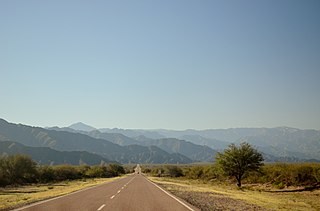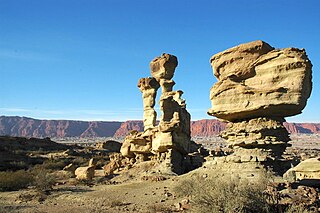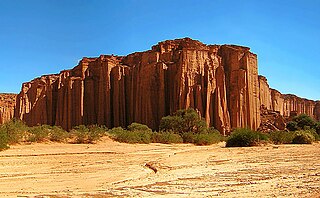
La Rioja, is the capital and largest city of La Rioja Province, Argentina, located in the east of the province.

Catamarca is a province of Argentina, located in the northwest of the country. The province had a population of 429,556 as per the 2022 census [INDEC], and covers an area of 102,602 km2. Its literacy rate is 95.5%. Neighbouring provinces are : Salta, Tucumán, Santiago del Estero, Córdoba, and La Rioja. To the west it borders the country of Chile.

San Juan Province is a province of Argentina, located in the western part of the country. Neighbouring provinces are, moving clockwise from the north, La Rioja, San Luis and Mendoza. It borders with Chile to the west.

La Rioja is a province of Argentina located in the west of the country. The landscape of the province consist of a series of arid to semi-arid mountain ranges and agricultural valleys in between. It is in one of these valleys that the capital of the province, the city of la La Rioja, lies. Neighboring provinces are from the north clockwise Catamarca, Córdoba, San Luis and San Juan. The dinosaur Riojasaurus is named after the province.

Malartic is a town on the Malartic River in northwestern Quebec, Canada, in the La Vallée-de-l'Or Regional County Municipality. It is located about 80 kilometres (50 mi) east of the centre of Rouyn-Noranda along Quebec Route 117 and the Canadian National Railway.

Cananea is a city in the Mexican state of Sonora, Northwestern Mexico. It is the seat of the Municipality of Cananea, in the vicinity of the U.S−Mexico border.

La Unión is situated in the Region of Murcia in the southeast of Spain. It has an area of 24.6 km², and had a population of 19,907 on 1 January 2018. It has an elevation of 86 m. Its average annual temperature is 17 °C. It has balmy winters. The sun shines 320 days per year. La Unión is situated in one of the sunniest areas in Europe; this kind of climate makes possible the many leisure activities, popular fiestas, sports, and cultural activities that are held in the town. The town is linked by a regular train to Cartagena which allows views of the past industrial heritage of the area and the more modern occupations of agriculture and tourism. La Unión lies within the built-up area of Cartagena and is surrounded on all landward sides by the City of Cartagena.

Chilecito is a city in the Argentine province of La Rioja, and head of the department of Chilecito.
Yamana Gold Inc. is a Canadian company that owns and operates gold, silver and copper mines in Canada, Chile, Brazil and Argentina. Headquartered in Toronto, the company was founded in 1994 and became listed on the Toronto Stock Exchange in 1995, the New York Stock Exchange in 2007, and the London Stock Exchange in 2020. The company became a gold producer after its 2003 re-restructuring in which Peter Marrone took over as chief executive officer and it merged with Brazilian company Santa Elina Mines Corporation. The combined company was able to use Yamana's access to capital with Santa Elina development properties to bring the Chapada mine into production. From there the company combined with other TSX-listed companies RNC Gold, Desert Sun Mining, Viceroy Exploration, Northern Orion Resources, Meridian Gold, Osisko Mining and Extorre Gold Mines which each contributed either a producing mine or a development project that was able to come into commercial production. The company was acquired by Pan American Silver in March 2023.
Cacán is an extinct language that was spoken by the Diaguita and Calchaquí tribes in northern Argentina and Chile. It became extinct during the late 17th century or early 18th century. The language was documented by the Jesuit Alonso de Bárcena, but the manuscript is lost. Genetic affiliation of the language remains unclear, and due to the extremely limited number of known words, it has not been possible to conclusively link it to any existing language family.
Villa Unión is a city in northwestern Argentina and the main settlement of Coronel Felipe Varela Department with a population of 12,263.

The Sierras Pampeanas is a geographical region of Argentina.

The Abitibi gold belt is a region of Canada that extends from Wawa, Ontario to Val-d'Or, Quebec. Located within the mineral-rich Abitibi greenstone belt, the gold belt is an established gold mining district having produced over 100 mines, and 170 million ounces of gold since 1901. Timmins, a town founded in 1912 following the Porcupine Gold Rush and subsequent creation of the Hollinger Mines, McIntyre Mines and Dome Mine, which was one area in the region that experienced a gold rush, beginning in 1909. The Kerr Addison Mine in Virginiatown was at one time Canada's largest gold producing mine. Many of the towns readily acknowledge gold mining as part of their history, some being named after gold. One of Canada's 'large roadside attractions' is a 12-foot replica of a 1908 gold sovereign built to commemorate Canada's first gold coin which was made using gold from the Kerr Addison owned Kerr-Addison mine.
Pituil is a town in the Famatina Department of La Rioja Province in northwestern Argentina.
Canadian mining in Latin America and the Caribbean began in the 20th century. Latin America and the Caribbean's vast resources give the region great geopolitical importance, attracting foreign interest for centuries. From the colonial race of European empires, to the multinationals of today's neoliberal capitalist world, this region continues to draw interest. Canada's involvement in Latin America increased dramatically since 1989 with several landmark negotiations and agreements. By 2009, the Canadian larger-company mineral exploration market in this region was valued at US$1.7 billion.

Famatina is an Argentinian Department in La Rioja Province.
Villa Castelli is a small town and seat of the General Lamadrid Department in the Province of La Rioja, northwestern Argentina. As of 2010 it had a population of 1,697.

Vicente Almandos Almonacid was an Argentine engineer, diplomat, and aviator who participated in the First World War as pilot of the French Air Force.

Nevado de Famatina is a peak in Argentina with an elevation of 6,115 metres (20,062 ft) metres. It is the highest point of Sierra de Famatina. It is located within the territory of the Argentinean province of La Rioja. Its slopes are within the administrative boundaries of the Argentinean cities: Famatina and Chilecito.
The Famatina mining protests opposed gold mining in La Rioja, Argentina beginning in 2011.












